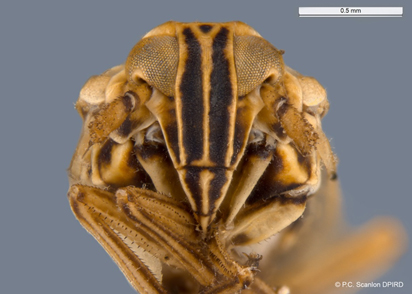Biosecurity threat, not present in Australia
Javesella spp
Caution
Many of the insects depicted on these pages are outwardly similar and you should not use photographs as the sole means of identification. These pages form part of a scientific key which will assist a trained entomologist to identify the species accurately.
Javesella discolor (Boheman, 1847)
Javesella dubia (Kirschbaum, 1868)
Javesella obscurella (Boheman, 1847)
Javesella pellucida (Fabricius, 1794)
Common Name: None known
Subfamily/Tribe: Delphacinae: Delphacini
Distribution: Javesella spp. are absent from Australia. All four of the species treated here are found throughout Europe, with some species reaching Asia (Javesella pellucida - Kazakhstan, Mongolia, Japan, Uzbekistan; Javesella dubia - Kazakhstan, Uzbekistan; Javesella obscurella - Mongolia) and northern Africa (Javesella discolour - Algeria; Javesella dubia - Azores, Morocco, Altai; Javesella pellucida – Azores, Algeria, Libya). Javesella discolor, Javesella obscurella and Javesella pellucida are also found in North America including Alaska and Canada. Javesella pellucida is the most widespread of the four species considered here, being also found in central America (Cuba, Puerto Rico) and the middle east (Iran, Lebanon) (Bartlett 2018; Bourgoin 2018)
Economic Status: The Javesella spp. considered here all feed on grasses (Poaceae), with Javesella pellucida being particularly polyphagous and capable of feeding on many different grass genera (Bartlett 2018). All four species feed on oats and are vectors of Oat sterile dwarf virus (Bartlett 2018), which is not present in Australia (Plant Health Australia 2014). Javesella obscurella, J. pellucida and J. dubia can also feed on wheat and transmit European wheat striate mosaic virus (Ammar 1975; Bartlett 2018), a virus currently absent from Australia (Brunt et al. 1996). Finally, Javesella pellucida feeds on barley and maize and is a vector of Maize rough dwarf virus, a virus that is not in Australia (Plant Health Australia, 2014). Of these four Javesella species, only J. pellucida is included on the Plant Health Australia (2015) contingency plan for exotic sap-sucking insects of grains.
Notes: There are 23 species of Javesella globally, all restricted to the Northern Hemisphere (see Bourgoin 2018). Although there are no species of Javesella in Australia, this genus can be difficult to distinguish from other Delphacini, particularly as males, females, brachypters (reduced wings) and macropters (fully winged) can all be differently patterned and coloured (e.g., Bantock & Botting 2013) .
Javesella pellucida (Fabricius, 1794)

